Modeling the Climate Suitability of Northernmost Mangroves in China under Climate Change Scenarios
Abstract
:1. Introduction
2. Materials and Methods
2.1. Study Areas and Mangrove Occurrence Data Collection
2.2. Environmental Variables under Climate Change
2.3. MaxEnt Modeling and Evaluation
2.4. Refining Procedure with Land-Use Data
3. Results
3.1. Model Evaluation and Environmental Drivers
3.2. Simulated Suitable Habitats and Their Shifts under Different Scenarios
3.3. Refined Results and the Effect of Land Use on Mangrove Habitats
4. Discussion
4.1. Environmental Drivers of Mangrove Distribution Change
4.2. Trend of Mangrove Habitat Shifts
4.3. Coastal Land Usage Influence and Study Uncertainty
5. Conclusions
Author Contributions
Funding
Acknowledgments
Conflicts of Interest
References
- Buelow, C.; Sheaves, M. A Birds-Eye View of Biological Connectivity in Mangrove Systems. Estuar. Coast. Shelf Sci. 2015, 152, 33–43. [Google Scholar] [CrossRef]
- Zhang, Y.; Ding, Y.; Wang, W.; Li, Y.; Wang, M. Distribution of Fish among Avicennia and Sonneratia Microhabitats in a Tropical Mangrove Ecosystem in South China. Ecosphere 2019, 10, 02759. [Google Scholar] [CrossRef] [Green Version]
- Rogers, K.; Saintilan, N.; Mazumder, D.; Kelleway, J.J. Mangrove Dynamics and Blue Carbon Sequestration. Biol. Lett. 2019, 15, 20180471. [Google Scholar] [CrossRef] [PubMed] [Green Version]
- Kelleway, J.J.; Cavanaugh, K.; Rogers, K.; Feller, I.C.; Ens, E.; Doughty, C.; Saintilan, N. Review of the Ecosystem Service Implications of Mangrove Encroachment into Salt Marshes. Glob. Change Biol. 2017, 23, 3967–3983. [Google Scholar] [CrossRef]
- Dasgupta, S.; Islam, M.S.; Huq, M.; Khan, Z.H.; Hasib, M.R. Quantifying the Protective Capacity of Mangroves from Storm Surges in Coastal Bangladesh. PLoS ONE 2019, 14, e0214079. [Google Scholar] [CrossRef]
- Alongi, D.M. Present State and Future of the World’s Mangrove Forests. Environ. Conserv. 2002, 29, 331–349. [Google Scholar] [CrossRef] [Green Version]
- Romañach, S.S.; DeAngelis, D.L.; Koh, H.L.; Li, Y.; Teh, S.Y.; Barizan, R.S.R.; Zhai, L. Conservation and Restoration of Mangroves: Global Status, Perspectives, and Prognosis. Ocean. Coast. Manag. 2018, 154, 72–82. [Google Scholar] [CrossRef]
- Alongi, D.M. Mangrove Forests: Resilience, Protection from Tsunamis, and Responses to Global Climate Change. Estuar. Coast. Shelf Sci. 2008, 76, 1–13. [Google Scholar] [CrossRef]
- Saintilan, N.; Khan, N.S.; Ashe, E.; Kelleway, J.J.; Rogers, K.; Woodroffe, C.D.; Horton, B.P. Thresholds of Mangrove Survival under Rapid Sea Level Rise. Science 2020, 368, 1118–1121. [Google Scholar] [CrossRef] [PubMed]
- Ai, B.; Ma, C.; Zhao, J.; Zhang, R. The Impact of Rapid Urban Expansion on Coastal Mangroves: A Case Study in Guangdong Province, China. Front. Earth Sci. 2020, 14, 37–49. [Google Scholar] [CrossRef]
- Hu, W.; Wang, Y.; Zhang, D.; Yu, W.; Chen, G.; Xie, T.; Liu, Z.; Ma, Z.; Du, J.; Chao, B.; et al. Mapping the Potential of Mangrove Forest Restoration Based on Species Distribution Models: A Case Study in China. Sci. Total Environ. 2020, 748, 142321. [Google Scholar] [CrossRef] [PubMed]
- Jia, M.; Wang, Z.; Zhang, Y.; Mao, D.; Wang, C. Monitoring Loss and Recovery of Mangrove Forests During 42 Years: The Achievements of Mangrove Conservation in China. Int. J. Appl. Earth Obs. Geoinf. 2018, 73, 535–545. [Google Scholar] [CrossRef]
- IPCC. Climate Change 2021: The Physical Science Basis. Contribution of Working Group I to the Sixth Assessment Report of the Intergovernmental Panel on Climate Change 2021; Summary for Policymakers, IPCC: Geneva, Switzerland, 2021. [Google Scholar]
- Osland, J.M.; Day, R.H.; Hall, C.T.; Brumfield, M.D.; Dugas, J.L.; Jones, W.R. Mangrove Expansion and Contraction at a Poleward Range Limit: Climate Extremes and Land-Ocean Temperature Gradients. Ecology 2017, 98, 125–137. [Google Scholar] [CrossRef] [PubMed]
- Record, S.; Charney, N.D.; Zakaria, R.M.; Ellison, A.M. Projecting Global Mangrove Species and Community Distributions under Climate Change. Ecosphere 2013, 4, 34. [Google Scholar] [CrossRef]
- Osland, J.M.; Feher, L.C.; Griffith, K.T.; Cavanaugh, K.C.; Enwright, N.M.; Day, R.H.; Stagg, C.L.; Krauss, K.W.; Howard, R.J.; Grace, J.B.; et al. Climatic Controls on the Global Distribution, Abundance, and Species Richness of Mangrove Forests. Ecol. Monogr. 2017, 87, 341–359. [Google Scholar] [CrossRef] [Green Version]
- Cavanaugh, C.K.; Osland, M.J.; Bardou, R.; Hinojosa-Arango, G.; Lopez-Vivas, J.M.; Parker, J.D.; Rovai, A.S. Sensitivity of Mangrove Range Limits to Climate Variability. Glob. Ecol. Biogeogr. 2018, 27, 925–935. [Google Scholar] [CrossRef] [Green Version]
- Wang, Q.W.; Wang, M. The Mangroves of China; Science Press: Beijing, China, 2007. [Google Scholar]
- IUCN. Global Assessments of Mangrove Losses and Degradation. 2016. Available online: https://www.iucn.org/sites/dev/files/content/documents/mangroveloss-brief-4pp-19.10.low.pdf (accessed on 1 June 2021).
- Center, National Marine Information. Blue Book on Marine Climate Change in China 2020; Science Press: Beijing, China, 2021. [Google Scholar]
- Ministry of Natural Resources, PRC. 2020 China Sea Level Bulletin; 2021. Available online: http://www.panjin.gov.cn:803/uploadfile/files/20210518134919655.pdf (accessed on 1 June 2021).
- Ma, Z.; Melville, D.S.; Liu, J.; Chen, Y.; Yang, H.; Ren, W.; Zhang, Z.; Piersma, T.; Li, B. Rethinking China’s New Great Wall. Science 2014, 346, 912–914. [Google Scholar] [CrossRef] [Green Version]
- Hangqing, F.; Guangzhao, L. Effect of Sea Dike on the Quantity, Community Characteristics and Restoration of Mangrove Forest Along Guangxi Coast. Chin. J. Appl. Ecol. 1997, 8, 240–244. [Google Scholar]
- Phillips, J.S.; Anderson, R.P.; Schapire, R.E. Maximum Entropy Modeling of Species Geographic Distributions. Ecol. Model. 2006, 190, 231–259. [Google Scholar] [CrossRef] [Green Version]
- Elith, J.; Phillips, S.J.; Hastie, T.; Dudík, M.; Chee, Y.E.; Yates, C.J. A Statistical Explanation of Maxent for Ecologists. Divers. Distrib. 2011, 17, 43–57. [Google Scholar] [CrossRef]
- Elith, J.; Graham, C.H.; Anderson, R.P.; Dudík, M.; Ferrier, S.; Guisan, A.; Hijmans, R.J.; Huettmann, F.; Leathwick, J.R.; Lehmann, A.; et al. Novel Methods Improve Prediction of Species’ Distributions from Occurrence Data. Ecography 2006, 29, 129–151. [Google Scholar] [CrossRef] [Green Version]
- Tang, X.; Yuan, Y.; Li, X.; Zhang, J. Maximum Entropy Modeling to Predict the Impact of Climate Change on Pine Wilt Disease in China. Front. Plant. Sci. 2021, 12, 652500. [Google Scholar] [CrossRef] [PubMed]
- Hausfather, Z.; Drake, H.F.; Abbott, T.; Schmidt, G.A. Evaluating the Performance of Past Climate Model Projections. Geophys. Res. Lett. 2020, 47, e2019GL085378. [Google Scholar] [CrossRef]
- Dang, N.A.T.; Kumar, L.; Reid, M.; Anh, L.N.T. Modelling the Susceptibility of Wetland Plant Species under Climate Change in the Mekong Delta, Vietnam. Ecol. Inform. 2021, 64, 101358. [Google Scholar] [CrossRef]
- John, E.; Bunting, P.; Hardy, A.; Roberts, O.; Giliba, R.; Silayo, D.S. Modelling the Impact of Climate Change on Tanzanian Forests. Divers. Distrib. 2020, 26, 1663–1686. [Google Scholar] [CrossRef]
- Jayasinghe, L.S.; Kumar, L. Modeling the Climate Suitability of Tea [Camellia sinensis (L.) O. Kuntze] in Sri Lanka in Response to Current and Future Climate Change Scenarios. Agric. For. Meteorol. 2019, 272–273, 102–117. [Google Scholar] [CrossRef]
- Zhou, Y.; Zhang, Z.; Zhu, B.; Cheng, X.; Yang, L.; Gao, M.; Kong, R. Maxent Modeling Based on Cmip6 Models to Project Potential Suitable Zones for Cunninghamia Lanceolata in China. Forests 2021, 12, 752. [Google Scholar] [CrossRef]
- Hu, W.; Chao, B.; Wang, Y.; Dong, P.; Zhang, D.; Yu, W.; Chen, G.; Chen, B. Assessing the Potential Distributions of Mangrove Forests in Fujian Province Using Maxent Model. China Environ. Sci. 2020, 40, 4029–4038. [Google Scholar]
- Fujian Meteorological Administration. Fujian Climate Bulletin. Available online: http://www.weather.com.cn/fujian/zxfw/qhgb/index.shtml (accessed on 7 December 2021).
- Chen, L.; Zheng, W.; Yang, S.; Wang, W.; Zhang, Y. Research Progresses of Mangrove Cold-Tolerant Classes and Seral Classes, and Their Responses to Climate Change. J. Xiamen Univ. Nat. Sci. 2017, 56, 305–313. [Google Scholar]
- Chen, L.; Wang, W.; Li, Q.Q.; Zhang, Y.; Yang, S.; Osland, M.J.; Huang, J.; Peng, C. Mangrove Species’ Responses to Winter Air Temperature Extremes in China. Ecosphere 2017, 8, 01865. [Google Scholar] [CrossRef]
- Ximenes, A.C.; Maeda, E.E.; Arcoverde, G.F.B.; Dahdouh-Guebas, F. Spatial Assessment of the Bioclimatic and Environmental Factors Driving Mangrove Tree Species’ Distribution along the Brazilian Coastline. Remote Sens. 2016, 8, 451. [Google Scholar] [CrossRef] [Green Version]
- Ward, D.R.; Friess, D.A.; Day, R.H.; A, R. MacKenzie. Impacts of Climate Change on Mangrove Ecosystems: A Region by Region Overview. Ecosyst. Health Sustain. 2016, 2, e01211. [Google Scholar] [CrossRef] [Green Version]
- Fick, E.S.; Hijmans, R.J. Worldclim 2: New 1-Km Spatial Resolution Climate Surfaces for Global Land Areas. Int. J. Climatol. 2017, 37, 4302–4315. [Google Scholar] [CrossRef]
- Tabor, K.; Williams, J.W. Globally Downscaled Climate Projections for Assessing the Conservation Impacts of Climate Change. Ecol. Appl. 2010, 20, 554–565. [Google Scholar] [CrossRef] [PubMed] [Green Version]
- Tyberghein, L.; Verbruggen, H.; Pauly, K.; Troupin, C.; Mineur, F.; de Clerck, O. Bio-Oracle: A Global Environmental Dataset for Marine Species Distribution Modelling. Glob. Ecol. Biogeogr. 2012, 21, 272–281. [Google Scholar] [CrossRef]
- Assis, J.; Tyberghein, L.; Bosch, S.; Verbruggen, H.; Serrão, E.A.; de Clerck, O. Bio-Oracle V2.0: Extending Marine Data Layers for Bioclimatic Modelling. Glob. Ecol. Biogeogr. 2018, 27, 277–284. [Google Scholar] [CrossRef]
- Ren, C.; Wang, Z.; Zhang, Y.; Zhang, B.; Chen, L.; Xi, Y.; Xiao, X.; Doughty, R.B.; Liu, M.; Jia, M.; et al. Rapid Expansion of Coastal Aquaculture Ponds in China from Landsat Observations during 1984–2016. Int. J. Appl. Earth Obs. Geoinf. 2019, 82, 101902. [Google Scholar] [CrossRef]
- Mao, D.; Wang, Z.; Du, B.; Li, L.; Tian, Y.; Jia, M.; Zeng, Y.; Song, K.; Jiang, M.; Wang, Y. National Wetland Mapping in China: A New Product Resulting from Object-Based and Hierarchical Classification of Landsat 8 Oli Images. ISPRS J. Photogramm. Remote Sens. 2020, 164, 11–25. [Google Scholar] [CrossRef]
- Feng, X.; Park, D.S.; Liang, Y.; Pandey, R.; Papeş, M. Collinearity in Ecological Niche Modeling: Confusions and Challenges. Ecol. Evol. 2019, 9, 10365–10376. [Google Scholar] [CrossRef] [Green Version]
- Muscarella, R.; Galante, P.J.; Soley-Guardia, M.; Boria, R.A.; Kass, J.M.; Uriarte, M.; Anderson, R.P. Enmeval: An R Package for Conducting Spatially Independent Evaluations and Estimating Optimal Model Complexity for Maxent Ecological Niche Models. Methods Ecol. Evol. 2014, 5, 1198–1205. [Google Scholar] [CrossRef]
- Jamwal, S.P.; di Febbraro, M.; Carranza, M.L.; Savage, M.; Loy, A. Global Change on the Roof of the World: Vulnerability of Himalayan Otter Species to Land Use and Climate Alterations. Divers. Distrib. 2021, 1–15. [Google Scholar] [CrossRef]
- Thuiller, W.; Richardson, D.M.; Rouget, M.; Procheş, Ş.; Wilson, J.R.U. Interactions between Environment, Species Traits, and Human Uses Describe Patterns of Plant Invasions. Ecology 2006, 87, 1755–1769. [Google Scholar] [CrossRef]
- Udyawer, V.; Somaweera, R.; Nitschke, C.; d’Anastasi, B.; Sanders, K.; Webber, B.L.; Hourston, M.; Heupel, M.R. Prioritising Search Effort to Locate Previously Unknown Populations of Endangered Marine Reptiles. Glob. Ecol. Conserv. 2020, 22, e01013. [Google Scholar] [CrossRef]
- Chen, J.; Ban, Y.; Li, S. Open Access to Earth Land-Cover Map. Nature 2014, 514, 434. [Google Scholar]
- Friess, A.D.; Krauss, K.W.; Horstman, E.M.; Balke, T.; Bouma, T.J.; Galli, D.; Webb, L.E. Are All Intertidal Wetlands Naturally Created Equal? Bottlenecks, Thresholds and Knowledge Gaps to Mangrove and Saltmarsh Ecosystems. Biol. Rev. 2012, 87, 346–366. [Google Scholar] [CrossRef]
- Feng, Z.; Tan, G.; Xia, J.; Shu, C.; Chen, P.; Wu, M.; Wu, X. Dynamics of Mangrove Forests in Shenzhen Bay in Response to Natural and Anthropogenic Factors from 1988 to 2017. J. Hydrol. 2020, 591, 125271. [Google Scholar] [CrossRef]
- McKee, L.K.; Cahoon, D.R.; Feller, I.C. Caribbean Mangroves Adjust to Rising Sea Level through Biotic Controls on Change in Soil Elevation. Glob. Ecol. Biogeogr. 2007, 16, 545–556. [Google Scholar] [CrossRef]
- Krauss, W.K.; Mckee, K.L.; Lovelock, C.E.; Cahoon, D.R.; Neil, S.; Ruth, R.; Luzhen, C. How Mangrove Forests Adjust to Rising Sea Level. New Phytol. 2014, 202, 19–34. [Google Scholar] [CrossRef] [Green Version]
- Fazlioglu, F.; Wan, J.S.H.; Chen, L.Z. Latitudinal Shifts in Mangrove Species Worldwide: Evidence from Historical Occurrence Records. Hydrobiologia 2020, 847, 4111–4123. [Google Scholar] [CrossRef]
- Saenger, P. Mangrove Ecology, Silviculture and Conservation; Springer: Dordrecht, The Netherlands, 2012. [Google Scholar]
- Peng, L.; Ruichi, S.; Changyi, L. The Characteristics of Chilling-Resistance on Six Mangrove Plants. J. Xiamen Univ. 1994, 33, 249–252. [Google Scholar]
- Saintilan, N.; Wilson, N.C.; Rogers, K.; Rajkaran, A.; Krauss, K.W. Mangrove Expansion and Salt Marsh Decline at Mangrove Poleward Limits. Glob. Change Biol. 2014, 20, 147–157. [Google Scholar] [CrossRef] [Green Version]
- Cavanaugh, C.K.; Kellner, J.R.; Forde, A.J.; Gruner, D.S.; Parker, J.D.; Rodriguez, W.; Feller, I.C. Poleward Expansion of Mangroves Is a Threshold Response to Decreased Frequency of Extreme Cold Events. Proc. Natl. Acad. Sci. USA 2014, 111, 723–727. [Google Scholar] [CrossRef] [Green Version]
- Godoy, D.M.; de Lacerda, L.D. Mangroves Response to Climate Change: A Review of Recent Findings on Mangrove Extension and Distribution. An. Acad Bras. Cienc. 2015, 87, 651–667. [Google Scholar] [CrossRef] [PubMed] [Green Version]
- Alongi, D.M. The Impact of Climate Change on Mangrove Forests. Curr. Clim. Change Rep. 2015, 1, 30–39. [Google Scholar] [CrossRef]
- Hickey, M.S.; Phinn, S.R.; Callow, N.J.; van Niel, K.P.; Hansen, J.E.; Duarte, C.M. Is Climate Change Shifting the Poleward Limit of Mangroves? Estuaries Coasts 2017, 40, 215–226. [Google Scholar] [CrossRef]
- Yiming, L.; Peng, L. The Status and Conservation of the Mangrove Resources in Fujian. Ecol. Econ. 1999, 16, 16–19. [Google Scholar]
- Liao, B.; Zhang, Q. Area, Distribution and Species Composition of Mangroves in China. Wetland Sci. 2014, 12, 435–440. [Google Scholar]
- Xiaoyong, C.; Peng, L. Responses and Roles of Mangroves in China to Global Climate Changes. Trans. Oceanol. Limnol. 1999, 2, 11–17. [Google Scholar]
- Fu, H.; Wang, W.; Ma, W.; Wang, M. Differential in Surface Elevation Change across Mangrove Forests in the Intertidal Zone. Estuar. Coast. Shelf Sci. 2018, 207, 203–208. [Google Scholar] [CrossRef]
- Laurance, F.W.; Dell, B.; Turton, S.M.; Lawes, M.J.; Hutley, L.B.; McCallum, H.; Dale, P.; Bird, M.; Hardy, G.; Prideaux, G.; et al. The 10 Australian Ecosystems Most Vulnerable to Tipping Points. Biol. Conserv. 2011, 144, 1472–1480. [Google Scholar] [CrossRef]
- Fu, H.; Zhang, Y.; Ao, X.; Wang, W.; Wang, M. High Surface Elevation Gains and Prediction of Mangrove Responses to Sea-Level Rise Based on Dynamic Surface Elevation Changes at Dongzhaigang Bay, China. Geomorphology 2019, 334, 194–202. [Google Scholar] [CrossRef]
- Quader, A.M.; Agrawal, S.; Kervyn, M. Multi-Decadal Land Cover Evolution in the Sundarban, the Largest Mangrove Forest in the World. Ocean. Coast. Manag. 2017, 139, 113–124. [Google Scholar] [CrossRef]
- Tuholske, C.; Tane, Z.; López-Carr, D.; Roberts, D.; Cassels, S. Thirty Years of Land Use/Cover Change in the Caribbean: Assessing the Relationship between Urbanization and Mangrove Loss in Roatán, Honduras. Appl. Geogr. 2017, 88, 84–93. [Google Scholar] [CrossRef]
- Schuerch, M.; Spencer, T.; Temmerman, S.; Kirwan, M.L.; Wolff, C.; Lincke, D.; McOwen, C.J.; Pickering, M.D.; Reef, R.; Vafeidis, A.T.; et al. Future Response of Global Coastal Wetlands to Sea-Level Rise. Nature 2018, 561, 231–234. [Google Scholar] [CrossRef] [PubMed]
- The State Council. Circular of the State Council on Strengthening the Protection of Coastal Wetlands and Strictly Regulating Sea Enclosure and Reclamation; 2018. Available online: http://www.gov.cn/zhengce/content/2018-07/25/content_5309058.htm (accessed on 1 June 2021).
- National Development and Reform Commission and Ministry of Natural Resources, PRC. National Master Plan for Major Ecosystem Protection and Restoration Projects (2021–2035); 2020. Available online: http://www.gov.cn/zhengce/zhengceku/2020-08/29/content_5538354.htm (accessed on 1 June 2021).
- Jagtap, G.T.; Nagle, V.L. Response and Adaptability of Mangrove Habitats from the Indian Subcontinent to Changing Climate. Ambio 2007, 36, 328–334. [Google Scholar] [CrossRef]
- Ellison, C.J.; Zouh, I. Vulnerability to Climate Change of Mangroves: Assessment from Cameroon, Central Africa. Biology 2012, 1, 617–638. [Google Scholar] [CrossRef] [Green Version]
- Zhang, Z. Studies on Ecosystem Function and Development of Mangrove in Fujian. Master’s Thesis, Fujian Agriculture and Forestry University, Fuzhou, China, 2007. [Google Scholar]
- Wang, Y.; Chao, B.; Dong, P.; Zhang, D.; Yu, W.; Hu, W.; Ma, Z.; Chen, G.; Liu, Z.; Chen, B. Simulating Spatial Change of Mangrove Habitat under the Impact of Coastal Land Use: Coupling Maxent and Dyna-Clue Models. Sci. Total Environ. 2021, 788, 147914. [Google Scholar] [CrossRef]
- Lee, Y.S.; Hamilton, S.; Barbier, E.B.; Primavera, J.; Lewis, R.R. Better Restoration Policies Are Needed to Conserve Mangrove Ecosystems. Nat. Ecol. Evol. 2019, 3, 70–72. [Google Scholar] [CrossRef]
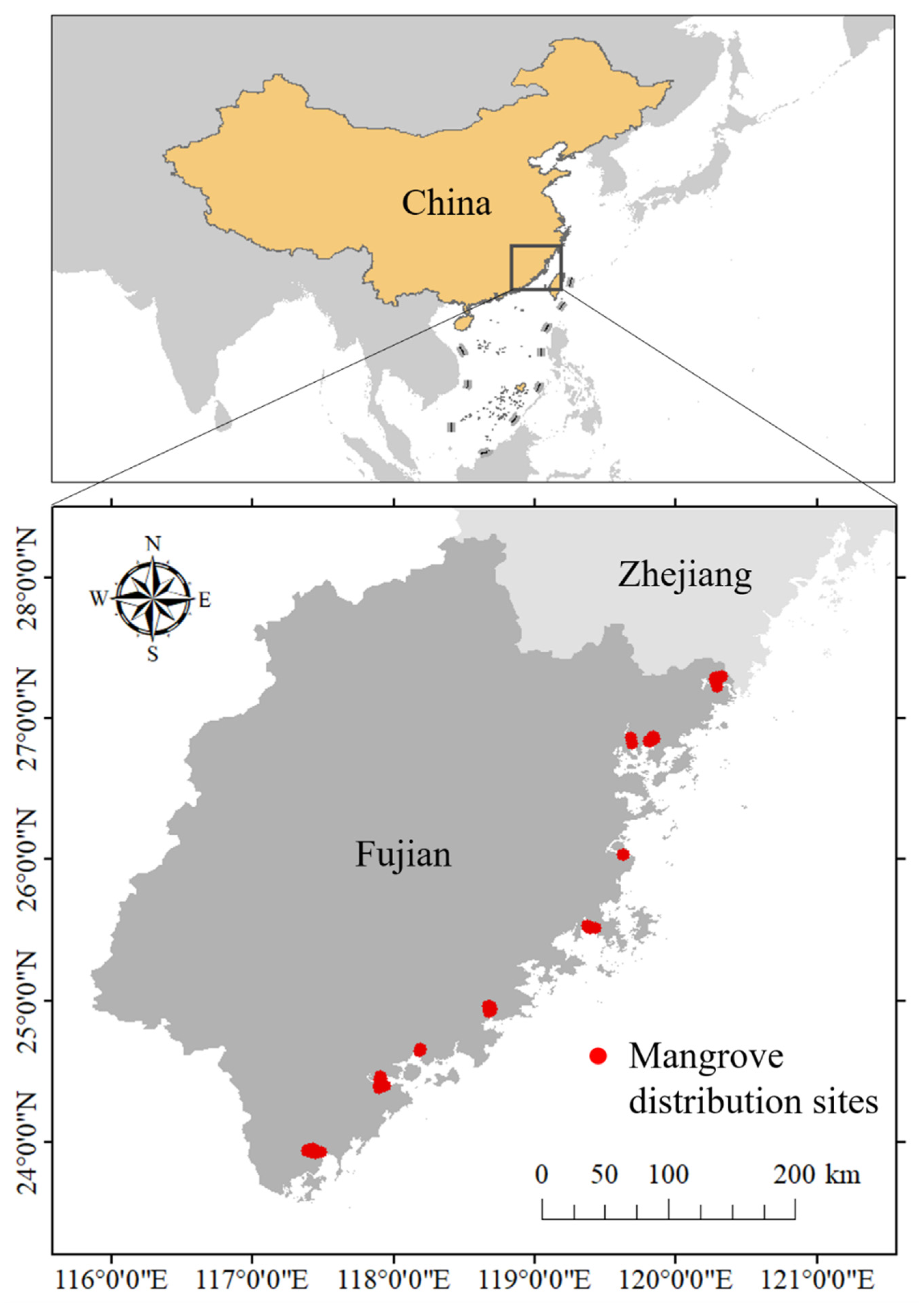
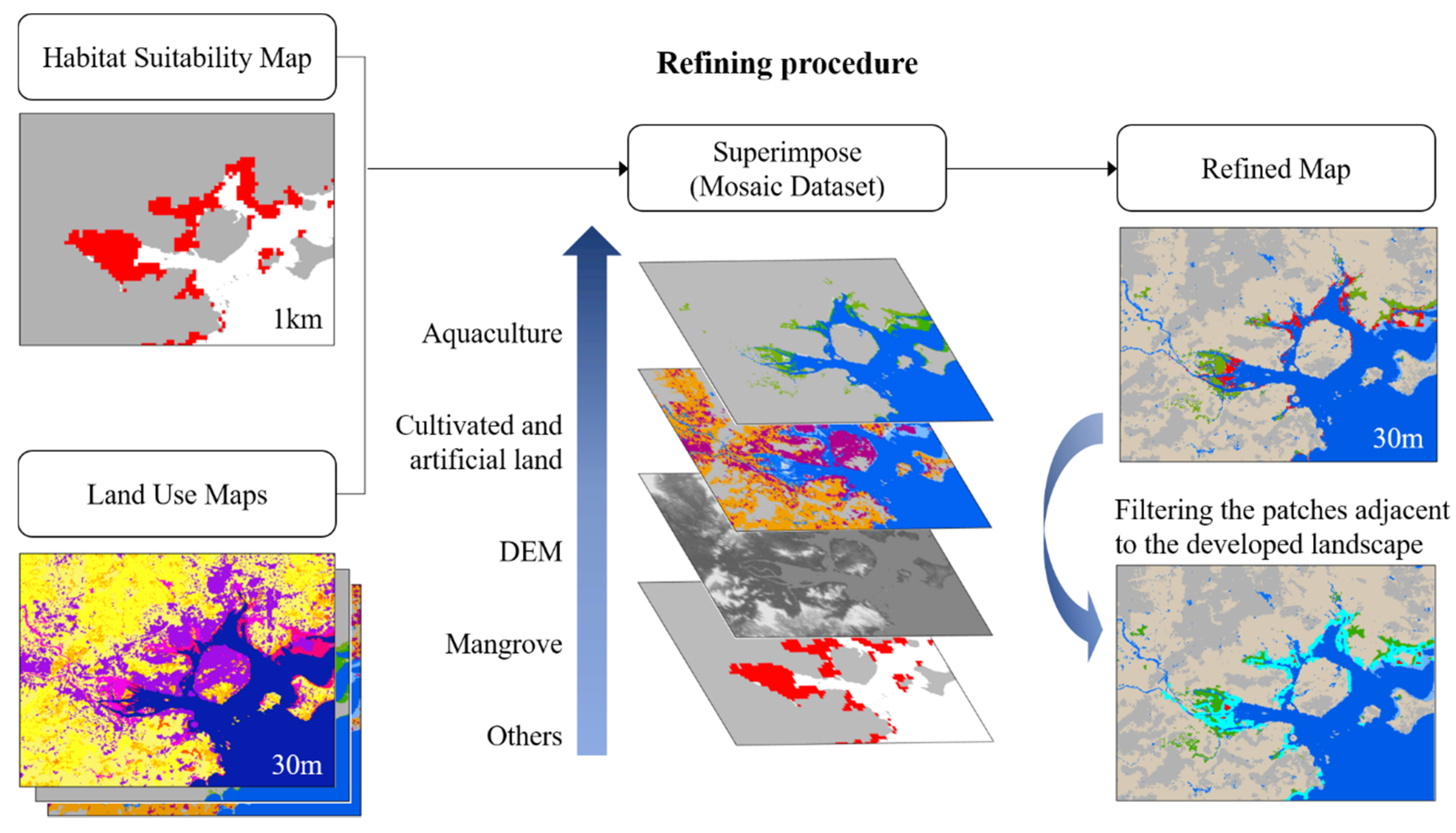

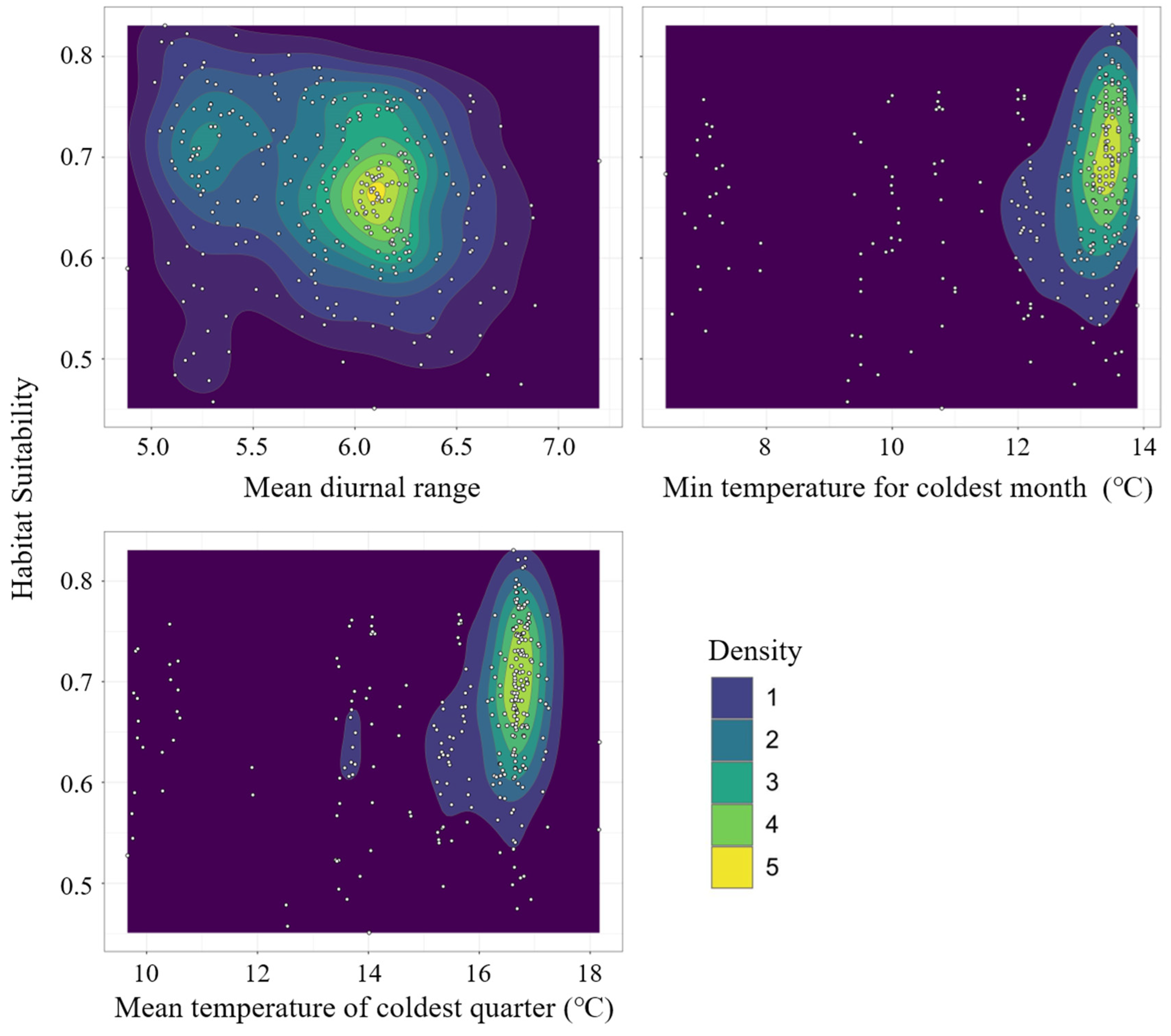
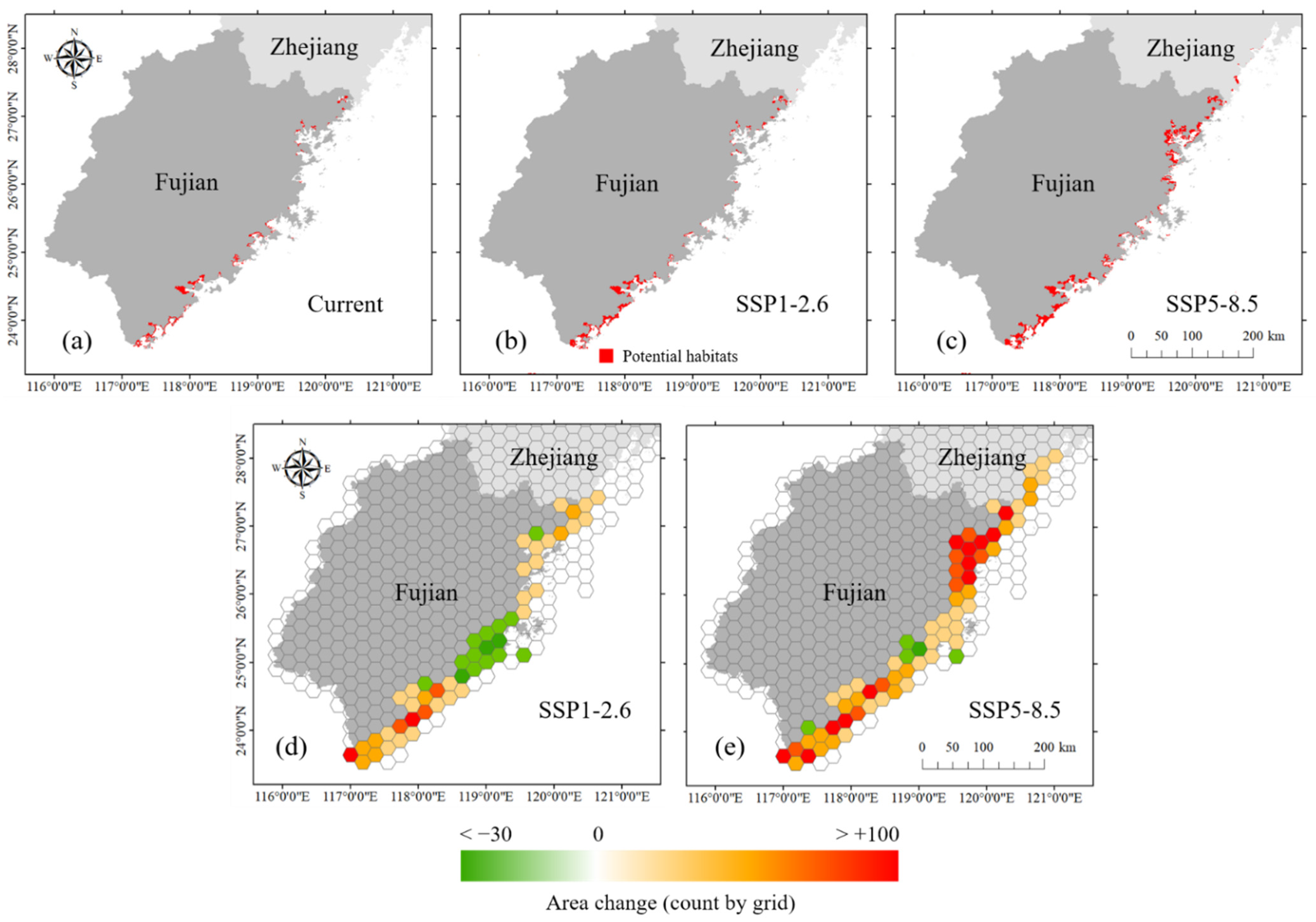
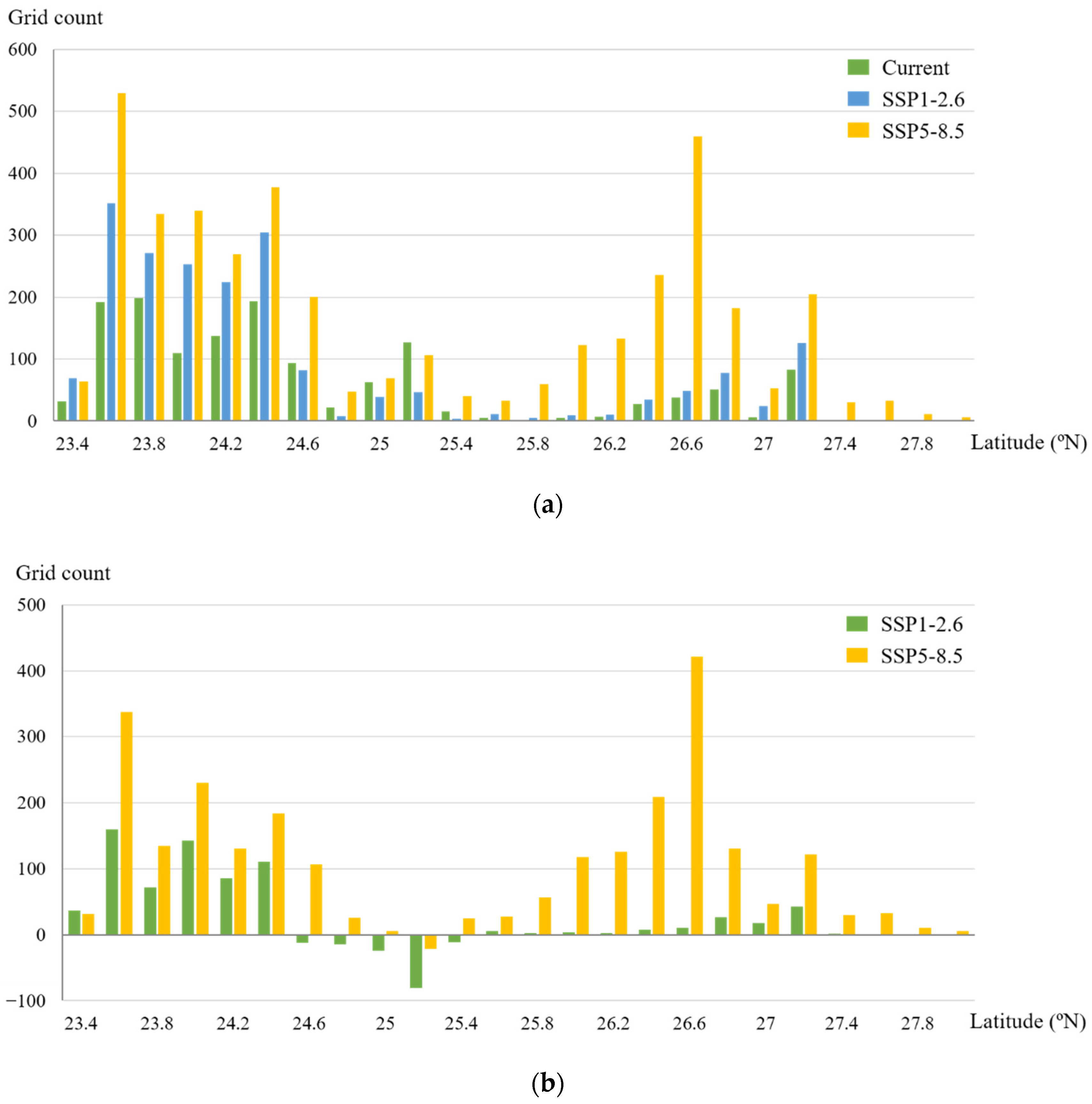
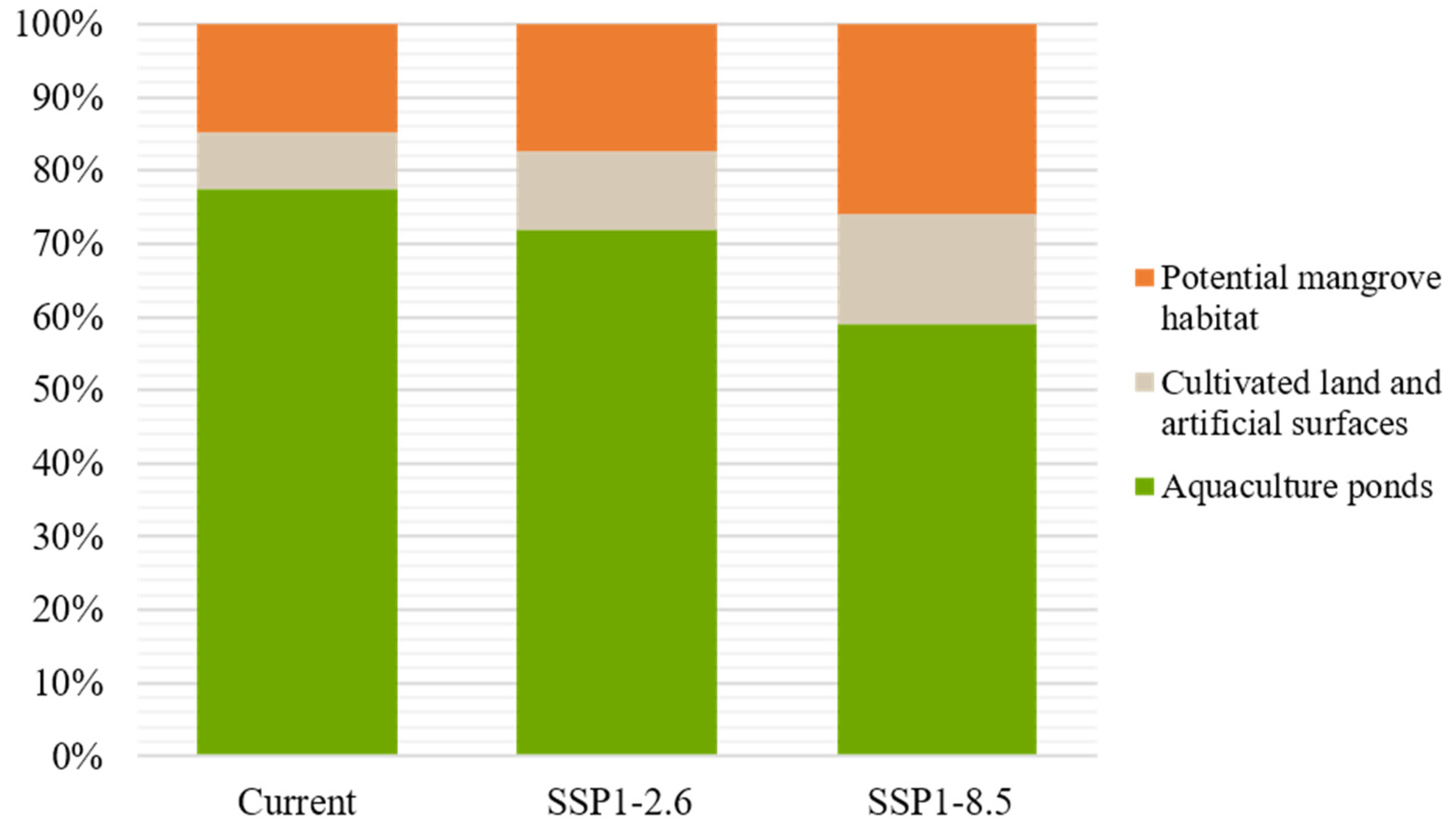
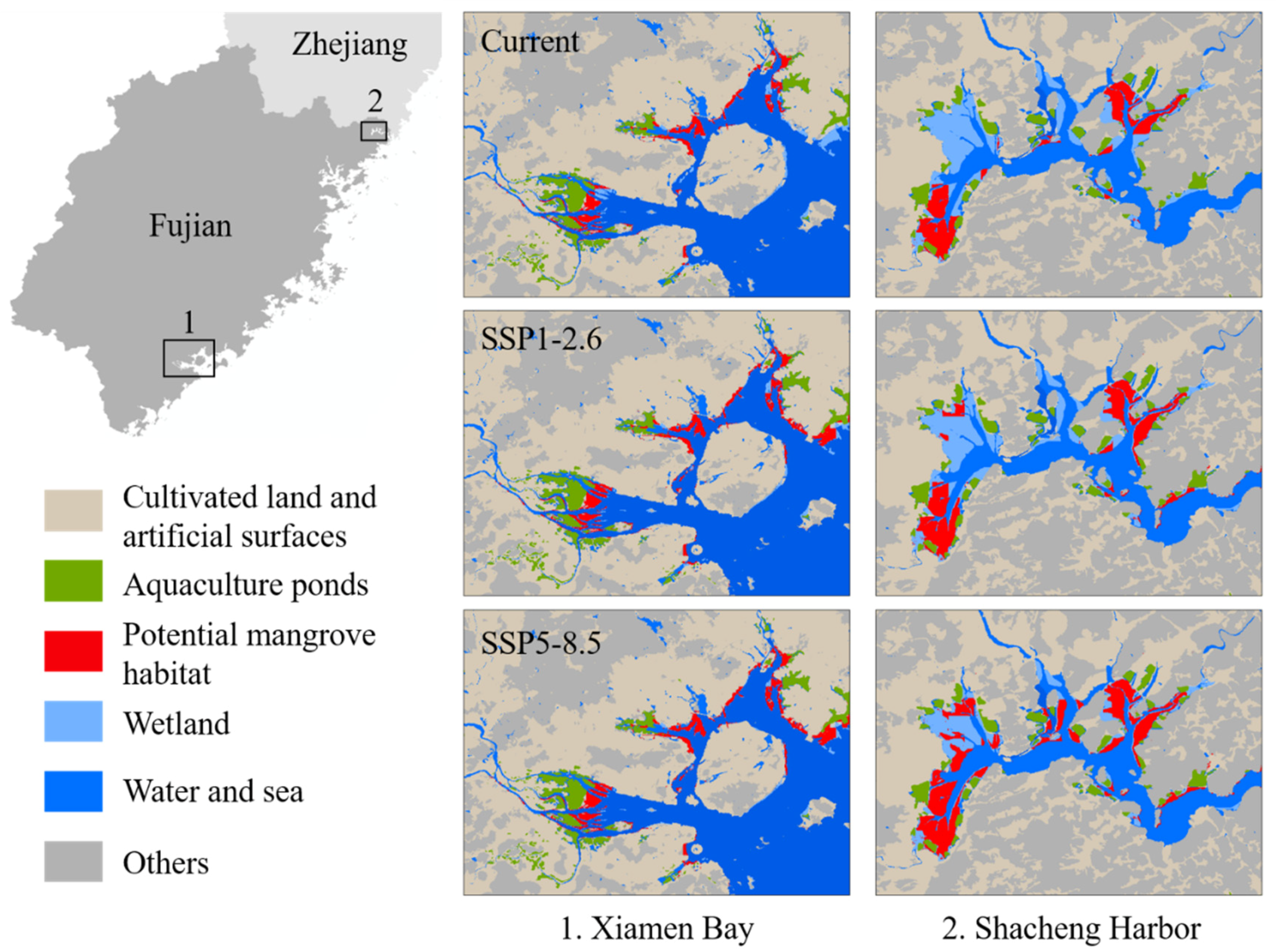
| Number | Type | Variable | Units |
|---|---|---|---|
| 1 | Bioclimatic | Annual mean temperature | °C |
| 2 | Bioclimatic | Mean diurnal range | °C |
| 3 | Bioclimatic | Isothermality | unitless |
| 4 | Bioclimatic | Temperature seasonality | unitless |
| 5 | Bioclimatic | Maximum temperature for warmest month | °C |
| 6 | Bioclimatic | Minimum temperature for coldest month | °C |
| 7 | Bioclimatic | Annual temperature range | °C |
| 8 | Bioclimatic | Mean temperature of wettest quarter | °C |
| 9 | Bioclimatic | Mean temperature of driest quarter | °C |
| 10 | Bioclimatic | Mean temperature of warmest quarter | °C |
| 11 | Bioclimatic | Mean temperature of coldest quarter | °C |
| 12 | Bioclimatic | Annual precipitation | mm |
| 13 | Bioclimatic | Precipitation of wettest month | mm |
| 14 | Bioclimatic | Precipitation of driest month | mm |
| 15 | Bioclimatic | Precipitation seasonality | unitless |
| 16 | Bioclimatic | Precipitation of wettest quarter | mm |
| 17 | Bioclimatic | Precipitation of driest quarter | mm |
| 18 | Bioclimatic | Precipitation of warmest quarter | mm |
| 19 | Bioclimatic | Precipitation of coldest quarter | mm |
| 20 | Topographic | Euclidean distance to coastline | m |
| 21 | Topographic | Compound topographic index | unitless |
| 22 | Topographic | Elevation | m |
| 23 | Topographic | Local deviation from global | unitless |
| 24 | Marine | Mean sea surface salinity | PSS |
| 25 | Marine | Sea surface salinity range | PSS |
| 26 | Marine | Mean sea surface temperature | °C |
| 27 | Marine | Minimum sea surface temperature | °C |
| 28 | Substrate | Intertidal substrate cover | type |
Publisher’s Note: MDPI stays neutral with regard to jurisdictional claims in published maps and institutional affiliations. |
© 2022 by the authors. Licensee MDPI, Basel, Switzerland. This article is an open access article distributed under the terms and conditions of the Creative Commons Attribution (CC BY) license (https://creativecommons.org/licenses/by/4.0/).
Share and Cite
Wang, Y.; Dong, P.; Hu, W.; Chen, G.; Zhang, D.; Chen, B.; Lei, G. Modeling the Climate Suitability of Northernmost Mangroves in China under Climate Change Scenarios. Forests 2022, 13, 64. https://doi.org/10.3390/f13010064
Wang Y, Dong P, Hu W, Chen G, Zhang D, Chen B, Lei G. Modeling the Climate Suitability of Northernmost Mangroves in China under Climate Change Scenarios. Forests. 2022; 13(1):64. https://doi.org/10.3390/f13010064
Chicago/Turabian StyleWang, Yuyu, Peng Dong, Wenjia Hu, Guangcheng Chen, Dian Zhang, Bin Chen, and Guangchun Lei. 2022. "Modeling the Climate Suitability of Northernmost Mangroves in China under Climate Change Scenarios" Forests 13, no. 1: 64. https://doi.org/10.3390/f13010064
APA StyleWang, Y., Dong, P., Hu, W., Chen, G., Zhang, D., Chen, B., & Lei, G. (2022). Modeling the Climate Suitability of Northernmost Mangroves in China under Climate Change Scenarios. Forests, 13(1), 64. https://doi.org/10.3390/f13010064






